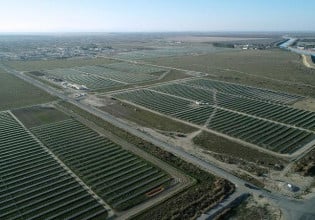LG Chem Fights Thermal Runaway with Flame Retardant Material
The new material from LG Chem delays thermal runaway by up to 20 minutes, even at 1,500°C. This article examines statistics quantifying the significance of thermal runaway and evaluates how LG Chem’s material is a promising solution.
Thermal runaway is one of the largest safety concerns in the battery space. A self-sustaining, exothermic chemical reaction where an increase in temperature causes further temperature increases, thermal runaway is a leading cause of fires in liquid electrolyte batteries, such as lithium-ion and LiFePo4.
LG Chem's CFT withstanding flames. Image used courtesy of LG Chem
LG Chem has developed a flame-retardant material they believe can help prevent thermal runaway in electric vehicle (EV) batteries.
Quantifying Thermal Runaway
It is well-accepted that thermal runaway is a major issue in battery safety, but how bad is it? Statistics can highlight the severity of thermal runaway incidents.
U.S. commercial air transportation studies have found 274 recorded thermal runaway incidents over approximately 23 years. Most startling, however, was that 76% of these incidents occurred since 2015. The predominant characteristic reported in these incidents was fire, with loose lithium batteries frequently implicated.
Trends in thermal runaway incidents and fatalities in China. Image used courtesy of Zhang et al.
An analysis of thermal runaway events in China provides more insight into the cause of these incidents. According to the study, in China's organic and inorganic industries, which represent 57.2% and 10.7% of the total thermal runaway incidents, respectively, it's found that human error is the leading cause, responsible for 35.4% of these events. This indicates that while technological safeguards are crucial, there is also a significant need for improved operational practices and training.
These statistics demonstrate that thermal runaway is a growing concern that warrants attention from industry, regulators, and safety professionals. Such events' increasing incidence and severity, especially in technologically sensitive environments like air transportation, show a pressing need for enhanced safety measures and more robust battery technologies.
A Flame Retardant Solution
In collaboration with LX Hausys, LG Chem has made a significant breakthrough in battery safety technology by developing a new material known as Special Flame Retardant Continuous Fiber Thermoplastic (CFT).
The material is engineered to withstand extreme temperatures up to 1,500°C for more than 20 minutes, a thermal resistance level representing a substantial leap forward from existing thermoplastics. The material's robustness against intense heat and pressure is over 14 times longer than current alternatives, which typically succumb to such conditions much sooner, leading to potential safety hazards.
EV battery fire. Image used courtesy of NHTSA
This material combines LG Chem's super flame barrier material technology with LX Hausys' Continuous Fiber Thermoplastics manufacturing technology. The combination results in a composite material that resists ignition and maintains structural integrity under severe thermal stress. This is particularly crucial in EV battery applications, where the containment of a thermal event within a single cell is vital to prevent it from propagating to adjacent cells, which could lead to catastrophic battery failures.
The material’s application extends beyond mere resistance to high temperatures, as it also exhibits low deformation under force, which is essential for maintaining the shape and structure of battery packs during thermal events. This characteristic ensures that the battery pack can serve as a protective barrier, buying critical time for vehicle occupants to evacuate in the event of a fire.
Solving a Big Problem
If the statistics are any indication, thermal runaway is a genuine and growing issue in the battery space. With a new flame retardant CFT material, LG Chem hopes to provide a solution that could tackle thermal runaway head-on and lead to a safer and more reliable future for the EV industry.









